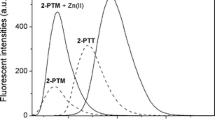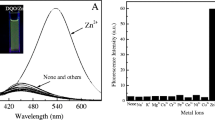Abstract
Three fluorescent sensors which were composed of a phendiol (o-, m-, p-isomers) and two carboxamidoquinolines have been synthesized and characterized. Research on the Zn2+-sensing properties of the three sensors was carried out, and the results showed a significant difference in the recognition performance for Zn2+. The fluorescence intensity (I510 nm) of ortho isomeric sensor binding to Zn2+ was enhanced 23-fold, the meta 15-fold, the para 8-fold. As the distance between two carboxamidoquinolines became longer, the fluorescence enhancement decreased. In addition, the selectivity of sensors got poor and the detection limit became higher with rising the distance between two receptors.









Similar content being viewed by others
References
Andreini C, Banci L, Bertini I, Rosato A (2006) Zinc through the three domains of life. J Proteome Res 5:3173–3178
Frassinetti S, Bronzetti G, Caltavuturo L, Cini M, Croce CD (2006) The role of zinc in life: a review. J Environ Pathol Toxicol Oncol 25:597–610
Cuajungco MP, Lees GJ (1997) Zinc metabolism in the brain: relevance to human neurodegenerative disorders. Neurobiol Dis 4:137–169
Wong LS, Khan F, Micklefield J (2009) Selective covalent protein immobilization: strategies and applications. Chem Rev 109:4025–4053
Yang Y, Zhao Q, Feng W, Li F (2013) Luminescent chemodosimeters for bioimaging. Chem Rev 113:192–270
Kobayashi H, Ogawa M, Alford R, Choyke PL, Urano Y (2010) New strategies for fluorescent probe design in medical diagnostic imaging. Chem Rev 110:2620–2640
Tomat E, Lippard SJ (2010) Imaging mobile zinc in biology. Curr Opin Chem Biol 14:225–230
Li X, Gao X, Shi W, Ma H (2014) Design strategies for water-soluble small molecular chromogenic and fluorogenic probes. Chem Rev 114:590–659
Xu ZC, Yoon JY, Spring DR (2010) Fluorescent chemosensors for Zn2+. Chem Soc Rev 39:1996–2006
Carter KP, Young AM, Palmer AE (2014) Fluorescent sensors for measuring metal ions in living systems. Chem Rev 114:4564–4601
Simmons JT, Allen JR, Morris DR, Clark RJ, Levenson CW, Davidson MW, Zhu L (2013) Integrated and passive 1, 2, 3-triazolyl groups in fluorescent indicators for Zinc (II) ions: thermodynamic and kinetic evaluations. Inorg Chem 52:5838–5850
Sumiya S, Shiraishi Y, Hirai T (2013) Mechanism for different fluorescence response of a coumarin–amide–dipicolylamine linkage to Zn (II) and Cd (II) in water. J Phys Chem A 117:1474–1482
Zhang JF, Kim S, Han JH, Lee SJ, Pradhan T, Cao QY, Lee SJ, Kang C, Kim JS (2011) Pyrophosphate-selective fluorescent chemosensor based on 1, 8-naphthalimide–DPA–Zn (II) complex and its application for cell imaging. Org Lett 13:5294–5297
Meeusen JW, Tomasiewicz H, Nowakowski A, Petering DH (2011) TSQ (6-methoxy- 8-p-toluenesulfonamido-quinoline), a common fluorescent sensor for cellular zinc, images zinc proteins. Inorg Chem 50:7563–7573
Ravikumar I, Ghosh P (2011) Zinc (II) and PPi selective fluorescence OFF–ON–OFF functionality of a chemosensor in physiological conditions. Inorg Chem 50:4229–4231
Fernández-Lodeiro J, Núñez C, de Castro CS, Bértolo E, Seixas de Melo JS, Capelo JL, Lodeiro C (2013) Steady-state and time-resolved investigations on pyrene-based chemosensors. Inorg Chem 52:121–129
Basa PN, Bhowmick A, Horn LM, Sykes AG (2012) Zinc (II) mediated imine–enamine tautomerization. Org Lett 14:2698–2701
Ingale SA, Seela F (2012) A ratiometric fluorescent on–off Zn2+ chemosensor based on a tripropargylamine pyrene azide click adduct. J Org Chem 77:9352–9356
Lin W, Buccella D, Lippard SJ (2013) Visualization of peroxynitrite-induced changes of labile Zn2+ in the endoplasmic reticulum with benzoresorufin-based fluorescent probes. J Am Chem Soc 135:13512–13520
Zhou Y, Li ZX, Zang SQ, Zhu YY, Zhang HY, Hou HW, Mak TCW (2012) A novel sensitive turn-on fluorescent Zn2+ chemosensor based on an easy to prepare C3-symmetric schiff-base derivative in 100% aqueous solution. Org Lett 14:1214–1217
Wang L, Qin W, Tang X, Dou W, Liu W (2011) Development and applications of fluorescent indicators for Mg2+ and Zn2+. J Phys Chem A 115:1609–1616
Pathak RK, Hinge VK, Mondal M, Rao CP (2011) Triazole-linked-thiophene conjugate of calix [4] arene: its selective recognition of Zn2+ and as biomimetic model in supporting the events of the metal detoxification and oxidative stress involving metallothionein. J Org Chem 76:10039–10049
Pathak RK, Tabbasum K, Rai A, Panda D, Rao CP (2012) Pyrophosphate sensing by a fluorescent Zn2+ bound triazole linked imino-thiophenyl conjugate of calix [4] arene in HEPES buffer medium: spectroscopy, microscopy, and cellular studies. Anal Chem 84:5117–5123
Song EJ, Kang J, You GR, Park GJ, Kim Y, Kim SJ, Kim C, Harrison RG (2013) A single molecule that acts as a fluorescence sensor for zinc and cadmium and a colorimetric sensor for cobalt. Dalton Trans 42:15514–15520
Pal P, Rastogi SK, Gibson CM, Aston DE, Branen AL, Bitterwolf TE (2011) Fluorescence sensing of zinc (II) using ordered mesoporous silica material (MCM-41) functionalized with N-(quinolin-8-yl)-2-[3-(triethoxysilyl) propylamino] acetamide. ACS Appl Mater Interfaces 3:279–286
Rastogi SK, Pal P, Aston DE, Bitterwolf TE, Branen AL (2011) 8-Aminoquinoline functionalized silica nanoparticles: a fluorescent nanosensor for detection of divalent zinc in aqueous and in yeast cell suspension. ACS Appl Mater Interfaces 3:1731–1739
Zhang Y, Guo XF, Jia LH, Xu SC, Xu ZH, Zheng LB, Qian XH (2012) Substituent-dependent fluorescent sensors for zinc ions based on carboxamidoquinoline. Dalton Trans 41:11776–11782
Mummidivarapu VSS, Tabbasum K, Chinta JP, Rao CP (2012) 1, 3-Di-amidoquinoline conjugate of calix [4] arene (L) as a ratiometric and colorimetric sensor for Zn2+: Spectroscopy, microscopy and computational studies. Dalton Trans 41:1671–1674
Tang LJ, Zhao J, Cai MJ, Zhou P, Zhong KL, Hou SH, Bian YJ (2013) An efficient sensor for relay recognition of Zn2+ and Cu2+ through fluorescence ‘off–on–off’ functionality. Tetrahedron Lett 54:6105–6109
Callan JF, de Silva AP, Magri DC (2005) Luminescent sensors and switches in the early 21st century. Tetrahedron 61:8551–8588
Zhang Y, Guo XF, Si WX, Jia LH, Qian XH (2008) Ratiometric and water-soluble fluorescent zinc sensor of carboxamidoquinoline with an alkoxyethylamino chain as receptor. Org Lett 10:473–476
Du JJ, Fan JL, Peng XJ, Li HL, Sun SG (2010) The quinoline derivative of ratiometric and sensitive fluorescent zinc probe based on deprotonation. Sensors Actuators B 144:337–341
Goswami S, Das AK, Aich K, Manna A, Maity S, Khanra K, Bhattacharyya N (2013) Ratiometric and absolute water-soluble fluorescent tripodal zinc sensor and its application in killing human lung cancer cells. Analyst 138:4593–4598
Yu H, Yu T, Sun M, Sun J, Zhang S, Wang S, Jiang H (2014) A symmetric pseudo salen based turn-on fluorescent probe for sensitive detection and visual analysis of zinc ion. Talanta 125:301–305
Lin HY, Cheng PY, Wan CF, Wu AT (2012) A turn-on and reversible fluorescence sensor for zinc ion. Analyst 137:4415–4417
Dong ZP, Guo YP, Tian X, Ma JT (2013) Quinoline group based fluorescent sensor for detecting zinc ions in aqueous media and its logic gate behaviour. J Lumin 134:635–639
Lee J, Kim H, Kim S, Noh JY, Song EJ, Kim C, Kim J (2013) Fluorescent dye containing phenol-pyridyl for selective detection of aluminum ions. Dyes Pigments 96:590–594
Goswami S, Maity S, Das AK, Maity AC (2013) Single chemosensor for highly selective colorimetric and fluorometric dual sensing of Cu (II) as well as ‘NIRF’ to acetate ion. Tetrahedron Lett 54:6631–6634
Acknowledgments
This work was supported by the National Natural Science Foundation of China (21176125), the Science Research Project of the Ministry of Education of Heilongjiang Province of China (12521594, 2012TD012, JX201205), the Natural Science Foundation of Heilongjiang province of China (B201114, B201313), and the Key Program of Science and Technology of Qiqihar, Heilongjiang Province (GYGG–201108).
Author information
Authors and Affiliations
Corresponding authors
Electronic supplementary material
Below is the link to the electronic supplementary material.
ESM 1
(DOC 1954 kb)
Rights and permissions
About this article
Cite this article
Tian, X., Guo, X., Jia, L. et al. Bi-8-carboxamidoquinoline Derivatives for the Fluorescent Recognition of Zn2+ . J Fluoresc 25, 441–449 (2015). https://doi.org/10.1007/s10895-015-1531-3
Received:
Accepted:
Published:
Issue Date:
DOI: https://doi.org/10.1007/s10895-015-1531-3




